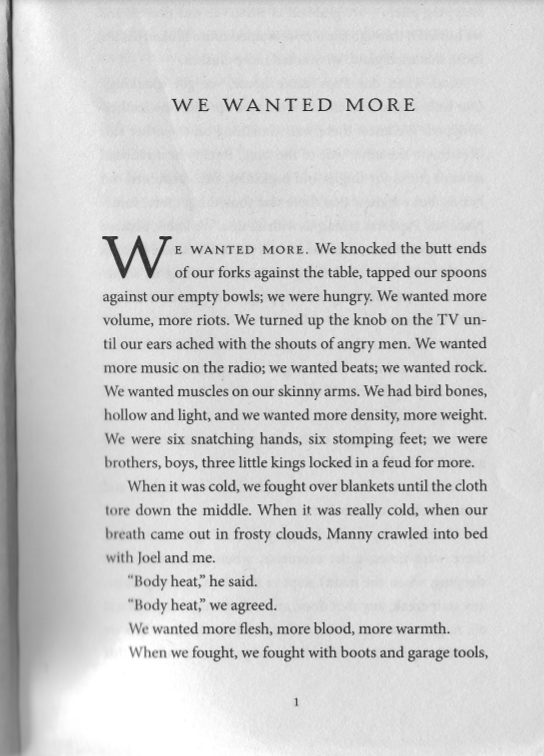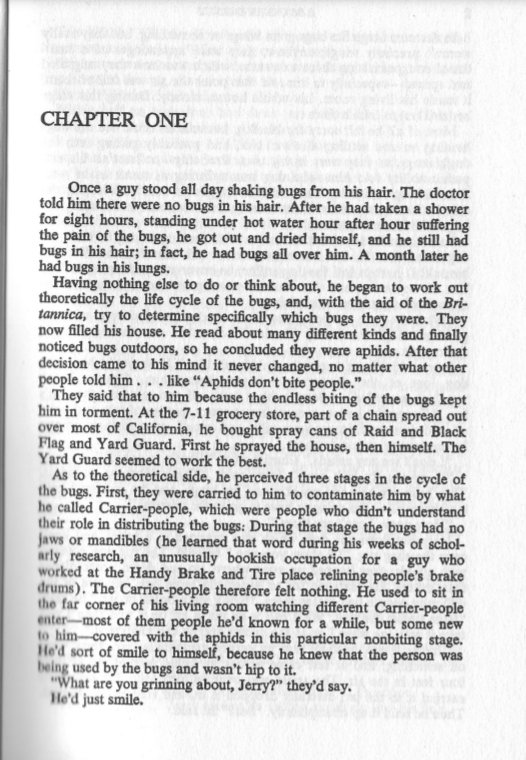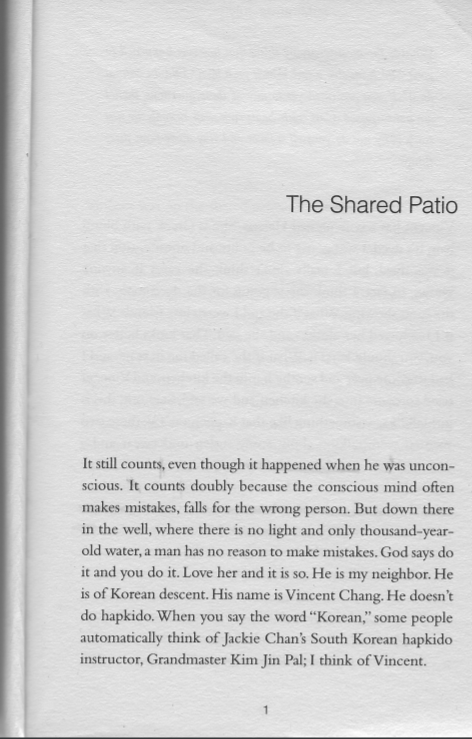18 January 2022

How a Tin Can Thinks
Crow’s Nest Creative Writers reconvened for a new term on Tuesday night to new and familiar faces, and while last minute train cancellations forced Antosh to come to us through the big screen rather than in-person this week, we nonetheless got the session started in the typical fashion...
From a prompt to describe their previous week as a hot beverage, the group's responses included: something undrunk to the point of having gone lukewarm, lemon honey tea so hot it burns your tongue, and a hot chocolate that even without marshmallows and cream is surprisingly tasty.
After being shared a couple of optional writing opportunities for our age group, including this young-persons call-out from John Hansard Gallery in partnership with ArtfulScribe (deadline: 7th February), we were introduced to the theme of the session - a requested focus: Character.
Antosh posited that even when a piece is decentralised from people, based instead around a room for example, that space can still act as a character. This was abstract thinking which proved a good lead in to the first exercise, where we crowdsourced objects as a group, coming up with three each, which gave us this list:
Book, Laptop, Table, Saxophone, Charger, Lemon, Phone, Plant, Crystal, Teddy Bear, Rope, Bathtub, Poster, Night Light, Bowl, Tin Can, Nail, Chair Leg, Lemon (x2), Vans, Willow Tree
Individually choosing one object from this pool, we were tasked with making spider diagrams of all our associations with that one object – its adjectives and characteristics.
We then pulled these into a (not necessarily realistic) personified character from any genre we liked (fantasy, sci-fi etc.) and profiled them, considering who they are, where they live, and what they do…
Once we had these profiles, we stepped back from them to discuss character design in more detail, considering how our impressions of a character have a lot to do with how they are first established to us i.e how we (the reader / audience) meet them.
This called for an examination of the storytelling tool In Media Res where a story or scene is begun in the middle of a crucial situation/drama/circumstance, using Justin Torres’s We The Animals as an example (see extract below).
We could see as a group how we had been dropped into the story We The Animals while it’s already going, not just arbitrarily where events might have ‘begun’ – a clear demonstration of In Media Res. Antosh also drew our attention to the perspective / register of address present in the extract – 1st person plural (“We”) – likening it to synecdoche, a word used to describe a figure of speech where a part is used to represent a whole.
The next task, influenced by what we had read, was to write about our character’s wants, in 1st person like in a diary entry.
After this, we considered narrative perspective more deeply (see slide below on homodiegetic and heterodiegetic narrators), looking at the opening of Phillip K Dick’s A Scanner Darkly (see extract below) as an example of a narrator who is distanced from the action. We felt the benefit of the heterodiegetic narrator in this case was separating objective reality from the character’s warped experience so the reader could distinguish the two.
We followed this by writing about our character in 3rd person; here was Conrad’s:
A man sat at a table, examining the faces of those around him - looking into their eyes for hints of their thoughts, their worries and their struggles. He had decided that his father was probably thinking about how to convince him to leave the house. “You’re 27” he would say, looking deeply into the man's eyes, “You have a lot of living to do and it should not be here.”, the father would then, at around this point in time, give some motion to his speech, such as a scratch on the chin or a solitary glance to the ceiling.” You have the means and the motive to move, so why don't you? You could just move on, you know, just move on.” He could not see how the man could not leave, as the man had all he wanted - there was nothing more he wanted than to live there. The man looked into his mothers eyes. They were embroidered with pure, deadly rage. The man saw this and placed his hand on hers and whispered into her ear - her rage wanted to stay, it really did, but it just was not strong enough to fight with comfort. He liked his time here. And the struggles were nothing and the conversations were nothing and the conflict was nothing and the people, the people were everything.
Finally, we turned to Miranda July’s Shared Patio (see extract below) as an example of a homodiegetic narrator, the benefit of which we felt to be their ability to touch on the idiosyncrasies of a person’s unfiltered thought pattern. Writing from inside our character’s head, our aim was tapping into the peculiar rhythm of how this person, who began the session as a night light, saxophone, or tin can, thinks...
Crow’s Nest will come together again next Tuesday evening at MAST.
Our Crowdsourced List of Objects

Justin Torres’s We The Animals

Homo/Hetero-Diegetic Narrators

Phillip K Dick’s A Scanner Darkly

Miranda July’s Shared Patio

Archive
Junior & Young Writers Week 3: Return From The Magical World
Junior & Young Writers Week 2: African Mythology
Problems, Problems, Problems...
Cautionary Tales & Christmassy Opening Lines
You've Gotta Have Pace, Pace, Pace
Junior & Young Writers Week 1: Alien Encounters
Junior & Young Writers: Week 5 - Play on Words Pt. 2
Junior & Young Writers: Week 11 - end of term showcase [build a bard workshop]
Junior & Young Writers: Week 10 - Greek Theatre - chorus stories
Junior & Young Writers: Week 9 - Greek Origin Stories - Spring
Rubber Ducks & Writing Festivals
Junior & Young Writers: Week 7 - Greek Hero Stories [the 12 labours of Hercules]
Junior & Young Writers: Week 12 [Wild Words] - Stuff & Things
Junior & Young Writers: Week 11 [Wild Words] - World Building 2
Junior & Young Writers: Week 10 [Wild Words] - World Building
Junior & Young Writers: Week 9 [Wild Words] - Mystery & Choose Your Own Adventure
Junior & Young Writers: Week 8 [Wild Words] - Spooky Sequels & Potion Poems
Junior & Young Writers – Week 10 (Writers’ Inspiration) – Final Showcase
Junior & Young Writers – Week 9 (Writers’ Inspiration) – Editing & Performance Tips
Junior & Young Writers – Week 8 (Writers’ Inspiration) – Cuteness
Time goes on by Tavinder Kaur New
Junior & Young Writers – Week 7 (Writers’ Inspiration) – Natural Solutions
Junior & Young Writers – Week 6 (Writers’ Inspiration) – The Language of Fruit and Veg
Junior & Young Writers – Week 5 (Writers’ Inspiration) – Adventures In Space
Tinklebobs and Bedraggled Angles
Junior & Young Writers – Week 4 (Writers’ Inspiration) – Our Environment
Fortune Tellers & Future Letters
Junior & Young Writers – Week 3 (Writers’ Inspiration) – Home
Young Writers - Week 10 (The Art of Writing) – Final Week Showcase
Junior Writers - Week 10 (The Art of Writing) – Final Week Showcase
Young Writers – Week 9 (The Art of Writing) – Choose Your Own Adventure
Junior Writers – Week 9 (The Art of Writing) – Choose Your Own Adventure
Young Writers – Week 8 (The Art of Writing) – Sequel Stories
Junior Writers – Week 8 (The Art of Writing) – Sequel Stories
Young Writers – Week 7 (The Art of Writing) – Picture Prompts
Junior Writers – Week 7 (The Art of Writing) – Picture Prompts
Young Writers - Week 6 (The Art of Writing) - Script-writing & Dialogue
Junior Writers - Week 6 (The Art of Writing) - Script-writing & Dialogue
Junior Writers – Week 5 (The Art of Writing) – Poetry
Young Writers - Week 5 (The Art of Writing) - Poetry Potions
Edward The Martyr - A Competition!
Mood Boards and Postcards from Space
Young Writers - Week 3 (The Art of Writing) - PLOT
Junior Writers - Week 3 (The Art of Writing) - PLOT
Moomin Stories and Hollywood Pitches
Young Writers - Week 2 (The Art of Writing) - Genre & Setting
Junior Writers - Week 2 (The Art of Writing) - Genre & Setting
Prompts, Dialogues, and Cliché
Story Structure Part One: Exposition and Beyond...
Young Writers - Week 1 (The Art of Writing) - Character
Junior Writers - Week 1 (The Art of Writing) - Character
Young Writers - week 4 - Nature Writing [animals & wildlife]
Junior Writers - week 4 - Nature Writing [animals & wildlife]
Young Writers - week 3 - Nature Writing [trees/plants/flowers]
Junior Writers - week 3 - Nature Writing [trees/plants/flowers]
Young Writers - week 2 - 'fractured fairy tales'
Junior Writers - week 2 - 'fractured fairy tales'
Young Writers - week 1 - 'from deep inside a forest'
Creating Communities through Writing
WORDCUP - Hounsdown Session #6
Making pillows in a house full of feathers
WORDCUP - Hounsdown Session #5
Exploring home – a place, person, house
WORDCUP - Hounsdown Session #4
Stories From Our Streets at the Abbeyfield Wessex Society Reminiscence Session at Poole Library
What Do You Really Mean? Writing Dialogue for Scripts
WORDCUP - Hounsdown Session #3
Character Building & Murder Mysteries
Going inside – from a spark to a story
WORDCUP - Hounsdown Session #2
Maybe I Can Be Invisible After All... Monologues
Creative Writing: Fun Facts, Diverse Voices and Different Perspectives
Writing Competition - Stories From Our Streets
Stories From Our Streets Community Activity Pack
Thinking in-quiet, after the fire
Found Cities, Lost Objects: Women in the City Curated by Lubaina Himid CBE
Ekphrastic Jukebox - Writing to Music
ArtfulScribe LitFest Community Showcase 2023
Young writers exercise their creative power
Writing to The Sorcerer's Apprentice
The Mousetrap - Mayflower Young and Junior Writers Investigate Mystery!
Stories From Our Streets Launch!
Interview: In Conversation with Dr Victoria Leslie
The Missing Farmer/ Blackout Poetry & DADA
Exploring this wonderful World
Using props to create characters/ working as a writing room
Stories of the Dust and Character Questions
Storytelling and Escalation or Rising Action
Junior Writers Club Acrostic Poem
Notes on Intention for MAST Collective - Year 3 - Facilitation Focus
Earthquakes & Dominoes - MAST Collective Blog #4
SUPER MARIO AND POP CULTURE POEMS
Receptionists & Inky Voids - MAST Collective Blog #3
Saying No and saying YES on National Poetry Day!
There's a Dragon in the Wardrobe...
House Warming Party (The Mortifying Ordeal of Being Known) - MAST Collective Blog #2
Intern Blog 5 - The Publishing Process
POEMS TO SOLVE THE CLIMATE CRISIS
On The Streets With Theresa Lola
Intern Blog 4 - The Internship Journey
NEW DIRECTIONS, STARTING SMALL - THE ORWELL YOUTH PRIZE
LIGHTHOUSES, HOPE AND METAPHORS
on workshop and transformations: frogs, lions, and the duck that becomes a larder...
Poetry Ambassadors - Interview with April Egan
Intern Blog 1 - Finding a Voice
World Poetry Day: Fluffypunk and the Invisible Women
On Being a Writer: A Conversation by Beth Phillips & Sam Morton
Poetry Ambassadors - Interview with Kaycee Hill
UNHEARD VOICES: INTERNATIONAL WOMEN'S DAY, AND STORIES OF CONFLICT













